
By Bob Stern - The University of Texas at Dallas
June 25, 2016
Hydrothermal vents are most commonly found near areas that are volcanically or tectonically active. So when scientists set out to explore Chamorro Seamount, which had no known historic eruptions, they weren't expecting to find vent communities... but they did. Seen at a depth of ~980 meters (3,215 feet), the hydrothermal vents on the outer southeast slope of the seamount's summit crater were indeed an unexpected, and exciting, discovery. Learn more here. Video courtesy of NOAA Office of Ocean Exploration and Research, 2016 Deepwater Exploration of the Marianas. Download (mp4, 101.2 MB).
Subduction of the Pacific Plate beneath the eastern margin of the Philippine Sea Plate generates a curved line of volcanoes – the Mariana island arc – that lies ~120 kilometers (80 miles) above the sinking plate. Some of these volcanoes are big enough to rise as much as 1,000 meters (3,300 feet) above sea level, like the twin giants of the Mariana volcanic arc, Pagan and Agrigan. Eight volcanic islands exist and many smaller volcanoes lie below sea level.
During Leg 3 of the 2016 Deep Water Exploration of the Marianas expedition, we explored five of these submarine volcanoes, along with the flank of an extinct island volcano (Maug), all in or near the “Islands Unit” of the Mariana Trench Marine National Monument. The locations of these dives are shown in the figure below.
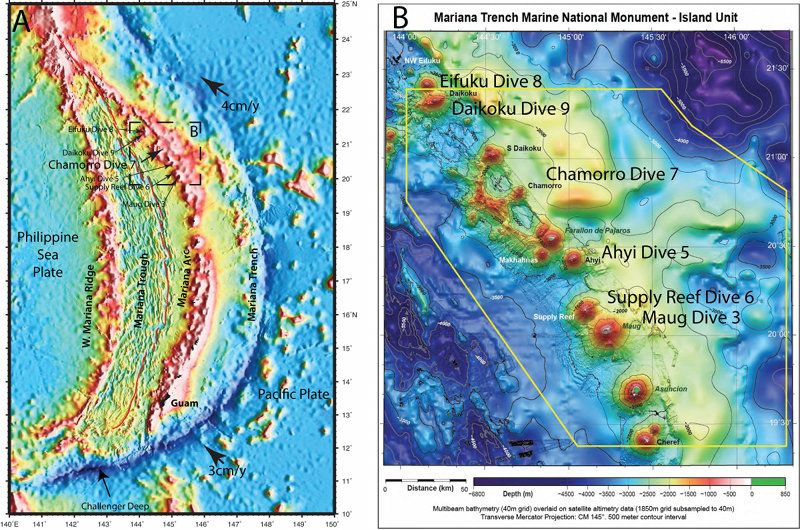
A: Bathymetric map of the Mariana arc system and location of arc volcanoes explored during Leg 3 of the expedition; arrows indicate approximate velocity of the Pacific Plate relative to the Marianas. B: Islands Unit of the Mariana Trench National Monument (yellow line) and surrounding region showing location of arc volcanoes explored during Leg 3. Location of the Chamorro submarine volcano is highlighted. Images courtesy of Bill Chadwick. Download larger version (jpg, 2.2 MB).
A modest submarine volcano “Chamorro” was the target of Leg 3 Dive 7 on June 24, 2016, which was a shallow-intermediate depth dive (~800-1,000 meters beneath the surface). Dr. Sherm Bloomer (Oregon State) and I named this volcano more than 30 years ago when we first surveyed and dredge-sampled it in 1985.
Chamorro Seamount has no known historical eruptions and we inferred from the relatively fresh appearance of the samples that we dredged in 1985 that Chamorro was dormant. The samples of lava that we recovered were unusual for the Mariana arc, containing visible minerals of hornblende, orthopyroxene, and plagioclase. When we analyzed their chemical composition, we found that the samples contained 66 weight percent SiO₂, much more than the ~50 weight percent SiO₂ found in basalts, the most common Mariana lava.
The Chamorro lavas are dacites, among the most compositionally evolved volcanic rocks found in the Mariana arc. The volcano was not studied again until NOAA marine geoscientists “sniffed” around it about a decade ago. They detected a modest ³He spike above it and concluded that it had “low-level” hydrothermal activity, consistent with what might be expected from a dormant volcano.
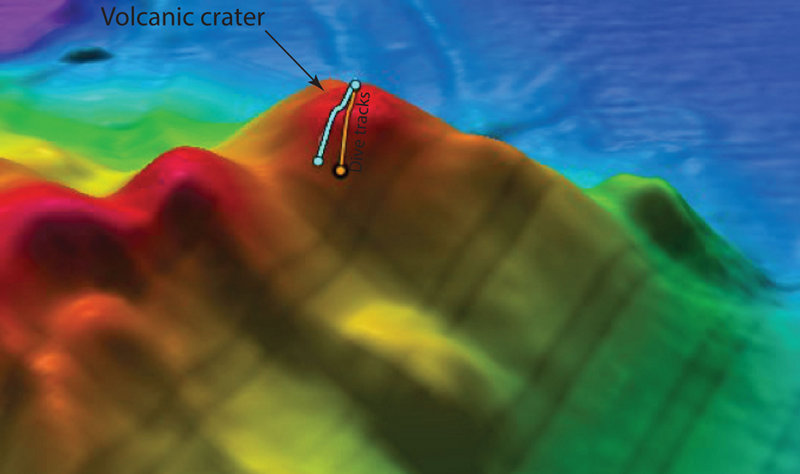
Pre-dive planning for dive, showing crater on top of volcano and two possible dive tracks. Image courtesy of the NOAA Office of Ocean Exploration and Research. Download larger version (jpg, 637 KB).
Could we use remotely operated vehicle (ROV) Deep Discoverer to find the hydrothermal activity on Chamorro? Drs. Maryjo Brounce (University of California Riverside), Sherm Bloomer, and I proposed a dive at one site, but after a pre-dive bathymetric survey by NOAA Ship Okeanos Explorer, Dr. Patty Fryer noticed a crater at the top of one peak. Volcanic craters are known to be associated with hydrothermal vents, and Patty suggested that we dive there instead, which turned out to be a great suggestion! We agreed to move the dive to explore the crater, and that’s where we found hydrothermal chimneys.
When we first landed on the seafloor, the volcano looked very quiet, with no signs of hydrothermal activity. We picked up a white pumice containing hornblende – hornblende dacite, similar to what we dredged 30 years ago! It seems that Chamorro is a dacite volcano, very different than the large basaltic volcanoes of the Mariana Islands to the south.
After we climbed the volcano and started exploring the crater, we saw signs of hydrothermal activity, including toppled-over chimneys and small (~one to two meters tall) towers. When we saw shimmering water coming out of some of the small towers and the “hairy snail” that always is associated with seafloor hydrothermal activity in the Marianas clustered around one of the small towers, we knew that we had found the vent field!
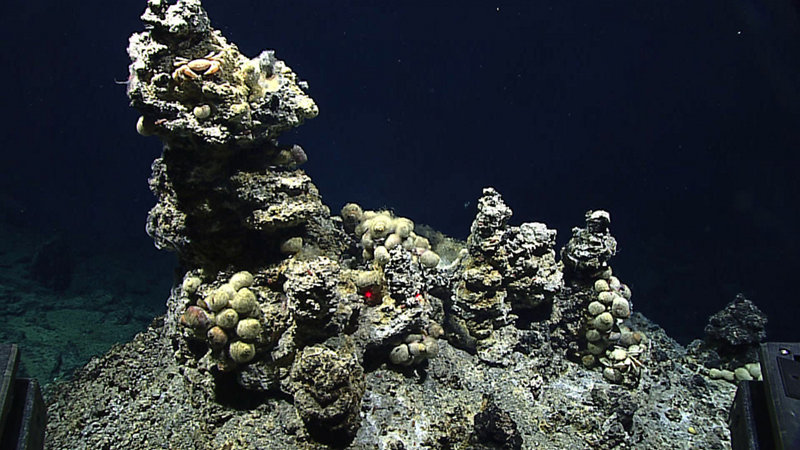
Small (approximately one meter tall) hydrothermal chimney with “hairy snails.” Image courtesy of the NOAA Office of Ocean Exploration and Research. Download larger version (jpg, 841 KB).
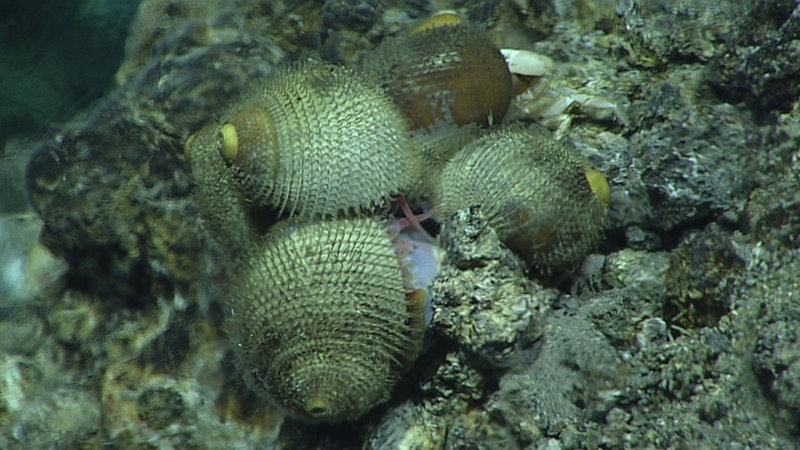
Close-up of “hairy snails;” these snails are known to live on hydrothermal vents in the Marianas. Image courtesy of the NOAA Office of Ocean Exploration and Research. Download larger version (jpg, 838 KB).
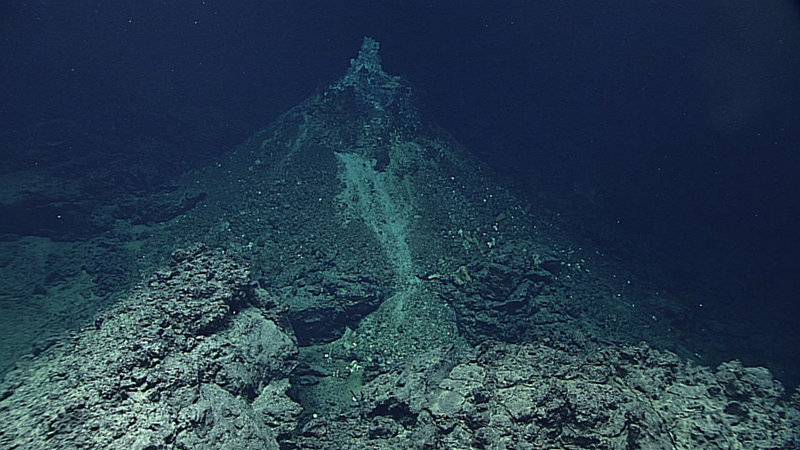
Hydrothermal chimney (white; approximately one meter tall) on top of hydrothermal mound (dark; ~10 meters tall); volcanic rocks in foreground. Image courtesy of the NOAA Office of Ocean Exploration and Research. Download larger version (jpg, 909 KB).
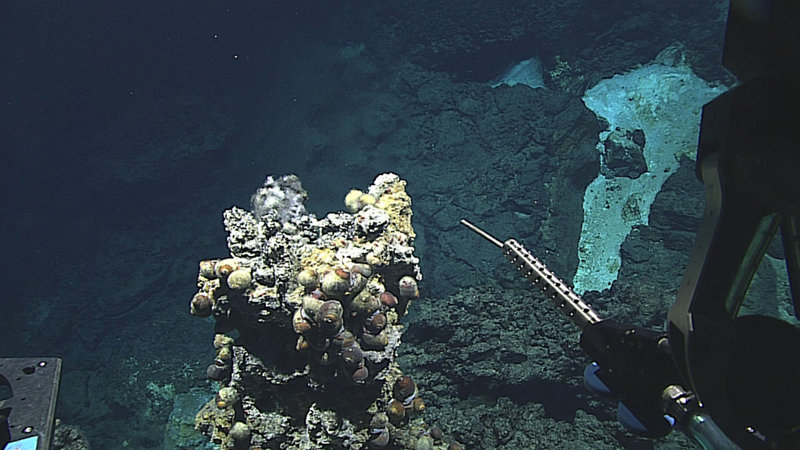
ROV Deep Discoverer preparing to insert a thermometer into a Chamorro chimney. Image courtesy of the NOAA Office of Ocean Exploration and Research. Download larger version (jpg, 779 KB).
Final confirmation came when we inserted the ROV thermometer into one of the chimneys and measured temperatures as high as 48°C, much hotter than seawater should be at this depth (only a few degrees).
The rest of the dive was spent exploring as many of these chimneys as we could before it was time to bring the ROV back up to the surface and head to the Dive 8 site.
Our sense of the Chamorro hydrothermal field is that it is waning, the dying output of a once-vigorous field. The fluids are not as hot as the vigorous vents and tall chimneys we observed in the back arc basin during Leg 1 where temperatures of vent fluid approached 300°C.
Chamorro vents were not yet completely dead like that discovered during Leg 1 in the Fina Nagu volcanic complex. But definitely, the Chamorro hydrothermal vents were a wonderful discovery!